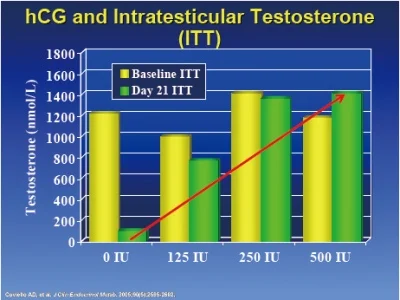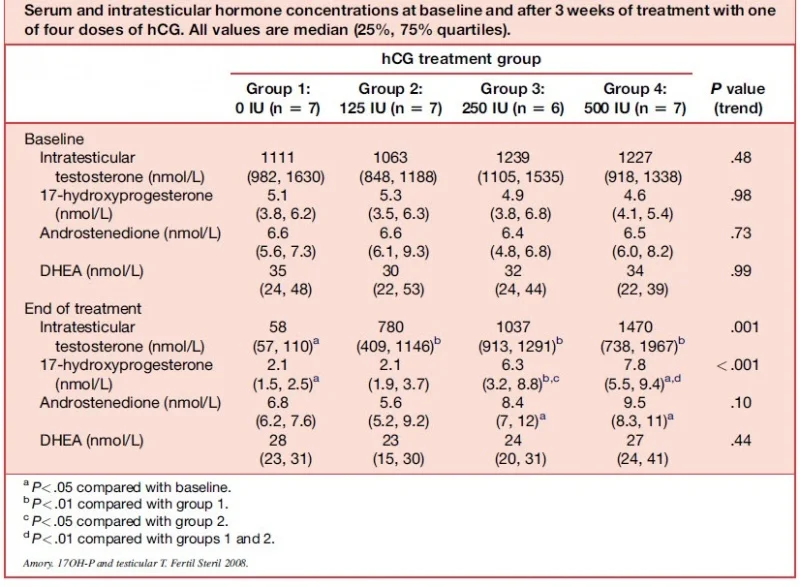Nelson Vergel
Founder, ExcelMale.com
The use of testosterone replacement therapy (TRT) increases blood levels of testosterone but, surprisingly, it decreases the level of testosterone inside the testicles (Intratesticular testosterone or ITT). ITT is key for proper sperm production and testicular size. This ITT decrease is due to the LH and FSH shut down that occurs with TRT. This shut down decreases ITT and sperm production in men on TRT. These two gonadotropins are required to maintain healthy levels of ITT and, thus, sperm production. Some men on TRT become infertile because of this issue. ITT levels are usually ten times higher than regular blood levels.
Several studies have found that using human chorionic gonadotropin (HCG) while on TRT can normalize ITT and sperm production. However, the optimum dose and frequency of HCG vary in every man. There are several ways to determine if the dose/frequency of HCG while on TRT is effective: Performing a sperm count/quality test and/or measuring an upstream hormone to testosterone called 17-hydroxyprogesterone (17OH-P). TRT decreases 17OH-P and other upstream hormones due to the shut down of LH (LH is needed to activate the production of these hormones- See figure below). When using HCG plus TRT, upstream hormones like 17OH-P can be normalized.

Several studies have found that 17OH-P blood level is correlated to ITT, so testing for this hormone could not only save time while optimizing HCG dose/frequency but also eliminate the need to perform testicular aspirations to measure ITT, a very difficult procedure to do. A 17OH-P level over 6.5 nmol/L (or 215 ng/dL) was found to normalize ITT while using HCG doses of 500 IU every other day plus testosterone enanthate injections given at 200 mg/week. But not all men’s ITT and sperm quality/quantity normalize on HCG + TRT.

References:
Amory et al. Serum 17-hydroxyprogesterone strongly correlates with intratesticular testosterone in gonadotropin suppressed normal men receiving various dosages of human chorionic gonadotropin. Fertility and Sterility. Vol. 89, No. 2, February 2008
For more information on the use of HCG to prevent/reverse testicular atrophy, infertility, and improve libido in men on TRT, please click here
BUY TEST HERE
The post Blood Test to Measure Efficacy of HCG in Men appeared first on Testosterone Wisdom.
Continue reading...
Several studies have found that using human chorionic gonadotropin (HCG) while on TRT can normalize ITT and sperm production. However, the optimum dose and frequency of HCG vary in every man. There are several ways to determine if the dose/frequency of HCG while on TRT is effective: Performing a sperm count/quality test and/or measuring an upstream hormone to testosterone called 17-hydroxyprogesterone (17OH-P). TRT decreases 17OH-P and other upstream hormones due to the shut down of LH (LH is needed to activate the production of these hormones- See figure below). When using HCG plus TRT, upstream hormones like 17OH-P can be normalized.
Several studies have found that 17OH-P blood level is correlated to ITT, so testing for this hormone could not only save time while optimizing HCG dose/frequency but also eliminate the need to perform testicular aspirations to measure ITT, a very difficult procedure to do. A 17OH-P level over 6.5 nmol/L (or 215 ng/dL) was found to normalize ITT while using HCG doses of 500 IU every other day plus testosterone enanthate injections given at 200 mg/week. But not all men’s ITT and sperm quality/quantity normalize on HCG + TRT.
References:
Amory et al. Serum 17-hydroxyprogesterone strongly correlates with intratesticular testosterone in gonadotropin suppressed normal men receiving various dosages of human chorionic gonadotropin. Fertility and Sterility. Vol. 89, No. 2, February 2008
For more information on the use of HCG to prevent/reverse testicular atrophy, infertility, and improve libido in men on TRT, please click here
BUY TEST HERE
The post Blood Test to Measure Efficacy of HCG in Men appeared first on Testosterone Wisdom.
Continue reading...
















